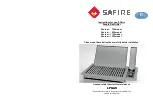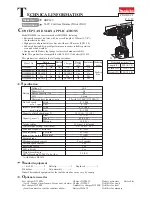
24
moist areas.
Never handle hot parts with unprotected
hands.
Never douse the barbecue with water when
its surfaces are hot.
In order to extend the life and maintain the
condition of your barbecue, we strongly
recommend that the unit be covered when left
outside for any length of time, especially during
the winter months. Heavy-duty barbecue covers
and other accessories are available from your
local stockist.
Even when your barbecue is covered for its
protection, it must be inspected on a regular
basis as damp or condensation can form which
may result in damage to the barbecue. It may
be necessary to dry the barbecue and the
inside of the cover. It is possible for mould to
grow on any fat remaining on parts of the
barbecue. This should be cleaned off smooth
surfaces with hot soapy water.
Any rust that is found that does not come into
contact with the food should be treated with a
rust inhibitor and painted with barbecue paint or
a heat resistant paint.
9.1. Cooking Surfaces & Warming Rack
When the barbecue has cooled, clean with hot
soapy water. To remove any food residue, use
a mild cream cleaner on a non-abrasive pad.
Do not use scouring pads or powders as they
can permanently damage the finish. Rinse well
and dry thoroughly. Due to the weight of the
cooking surfaces, we do not recommend
cleaning in a dishwasher.
9.2. Burner
Provided that they are operating correctly, in
normal usage, burning off the residue after
cooking will keep the burners clean.
The burners should be removed and cleaned
annually, or whenever heavy build-up is found,
to ensure that there are no signs of blockage
(debris, insects) in either the burner portholes or
the primary air inlet of the burners. Use a pipe
cleaner to clear obstructions.
When refitting the burners, be careful to check
that the neck of the burner fits over the valve
outlet.
It is quite normal for surface rust to be present
on the burners. If rust appears between uses or
in storage, clean with a soft brass wire brush.
9.3. Flame Tamer (where supplied)
Remove any food residue from the flame tamer
surface with a plastic or wooden scraper or
brass wire brush. Do not use a steel scraper or
wire brush. Clean with hot soapy water and
rinse well.
9.4. Lava Rock (where supplied)
It is not necessary to remove and wash the lava
rock in order to keep it clean. Burning off the
residue for 3 to 5 minutes after each cooking
session should be sufficient. Heavily
impregnated lava rock should be turned over so
that the dirty side faces the burners in order to
burn off any residue. Replacement lava rock is
available from your local stockist.
9.5. Drip Tray
After every use, empty and clean the drip tray
(and foil liner, if applicable) of any fat or food
particles, using a plastic or wooden scraper if
necessary.
Failure to keep it clean, and excessive build up
can result in a fat fire. This can be hazardous
and severely damage the barbecue.
This is not
a fault in the barbecue and is therefore not
covered by the terms of the warranty.
If
required, the tray can be washed in hot soapy
water.
9.6. Barbecue Body
Regularly remove excess grease or fat from the
barbecue body using a cloth wrung out in hot
soapy water and dry thoroughly. Excess fat and
food debris can be removed from inside the
body using a soft plastic or wooden scraper. It
is not necessary to remove all the grease from
the body. If you need to clean fully, use hot
soapy water and a cloth, or nylon-bristled brush
only. Do not use abrasives. Remove cooking
surfaces and burners before full cleaning. Do
not immerse the gas controls or manifold in
water. Check burner operation after carefully
refitting into body.
A stainless steel cleaner may be used on
stainless steel parts if required.
9.7. Barbecue Hood or Lid
Use a non-abrasive cloth or pad and clean with
hot, soapy water. Do not use scouring pads or
powders as they can permanently damage



































